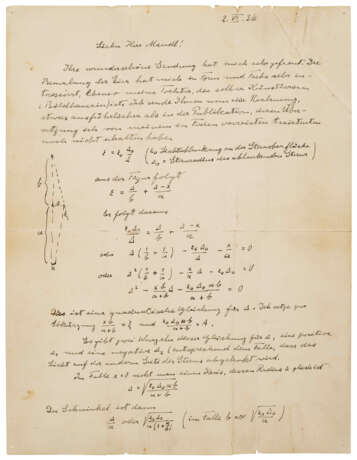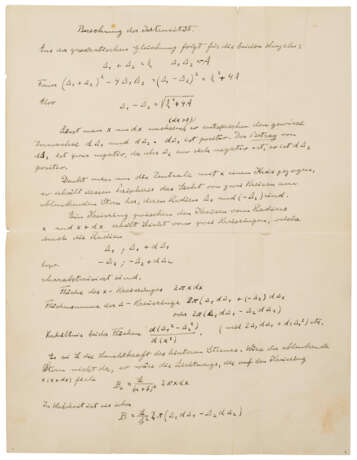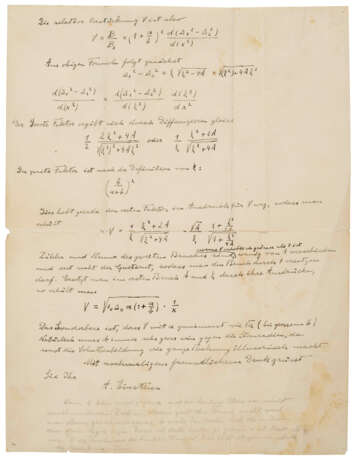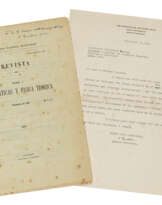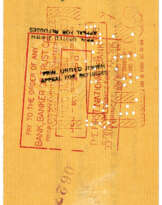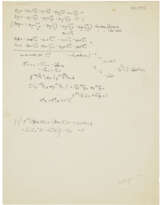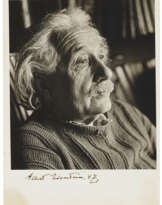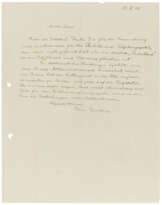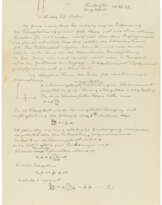ID 993371
Lot 87 | EINSTEIN, Albert (1879-1955).
Estimate value
£ 50 000 – 80 000
Autograph letter signed (‘A. Einstein’) to [Rudi W.] Mandl, [Princeton], 2 June 1936.
In German. 3 pages in pen with a postscript in pencil, 280 x 215mm, including a diagram of a gravitational lens and more than 30 calculations and equations; with a proof dated 25 November 1936 of Einstein’s article, ‘Lens-like action of a star by the deviation of light in the gravitational field’ (published in Science, 4 December 1936), one leaf, 490 x 185mm. Provenance: collection of Harvey Plotnick; his sale, Christie’s New York, 4 October 2002, lot 100. Formally unpublished.
On gravitational lensing: detailed calculations relating to the gravitational deflection of
light. In this highly important letter, arguably Einstein’s most substantial statement on the subject of gravitational lensing, Einstein here sets out the mathematical calculations that underlie his only article on the topic, ‘Lens-like action of a star by the deviation of light in the gravitational field’. Beginning with a diagram of the gravitational lens, Einstein defines the meaning of ‘light deflection at the surface of the star’ and the ‘stellar radius of the deflecting star’, and then proceeds to derive a quadratic equation for the actual deflection of light. On a second page entitled ‘Calculation of the intensity’, Einstein visualises ‘a circle drawn around the center with x’, whose ‘periphery receives the light from two circles on the deflecting star’; and he then proceeds to define the term L, ‘the luminosity of the rear star’, so as to calculate how much light would reach the viewing point if the refracting star were not there, before providing the equation for the ‘relative strengthening’ provided by the gravitational lensing. He concludes ‘Of course, b [the distance between the star and the deflecting star] must always be very large compared to the radii of the stars, otherwise the shadow formation would make the whole calculation illusory’. The penciled postscript considers the situation if the distance from the deflecting star to the observation point diminishes in relation to that between the star and the deflecting star.
Although Einstein had posited the gravitational deflection of light as early as 1911, and it was central
to the celebrated empirical validation of general relativity in 1919, he did not seriously consider that
the deflection could function as a lens – what is now known as ‘gravitational lensing’ – until an
encounter with Rudi Mandl in 1936. Born in Moravia, Rudi W. Mandl (1894-1948) had emigrated to
the US in 1923, and was working as a busboy and restaurant dishwasher in Washington DC when he
visited Einstein on 17 April 1936 to discuss the potential lensing effect. In December 1936 Einstein
published an article on lensing (an early proof of which is enclosed here), which pays tribute to
Mandl’s role in bringing the matter to his attention. Einstein’s article is both brief and relatively non-mathematical in nature; and as Einstein here says, the equations in the present letter are considerably more detailed than those in the published article. In their article on 'The Origin of Gravitational Lensing’ (Science, 1997), Jurgen Renn, Tilman Sauer, and John Stachel confirm that the present letter enfolds the key equations of the article. This letter is formally unpublished.
In spite of Einstein’s pessimistic conclusion to the paper, that ‘there is no great chance of observing this phenomenon, even if dazzling by the light of the much nearer star B is disregarded’, the effect of gravitational lensing was experimentally confirmed in 1979, with the discovery of the Twin Quasar, a single quasar which appears as two images as a result of gravitational lensing by a galaxy located directly between Earth and the quasar. Since then, dozens of lens systems have been observed, and gravitational lensing has been used to observe the most distant and earliest-formed galaxies, with fundamental implications for the parameters of Big Bang models.
Special notice
This lot has been imported from outside of the UK for sale and placed under the Temporary Admission regime. Import VAT is payable at 5% on the hammer price. VAT at 20% will be added to the buyer’s premium but will not be shown separately on our invoice.
| Artist: | Albert Einstein (1879 - 1955) |
|---|---|
| Place of origin: | Western Europe, Germany, Europe, Switzerland |
| Auction house category: | Letters, documents and manuscripts, Medicine & science |
| Artist: | Albert Einstein (1879 - 1955) |
|---|---|
| Place of origin: | Western Europe, Germany, Europe, Switzerland |
| Auction house category: | Letters, documents and manuscripts, Medicine & science |
| Address of auction |
CHRISTIE'S 8 King Street, St. James's SW1Y 6QT London United Kingdom | |
|---|---|---|
| Preview |
| |
| Phone | +44 (0)20 7839 9060 | |
| Buyer Premium | see on Website | |
| Conditions of purchase | Conditions of purchase |
